Early decisions pay when growing chickpeas and faba beans
Early decisions pay when growing chickpeas and faba beans
Author: Stacey Power, (Department of Primary Industries and Regional Development) | Date: 23 Feb 2021
Key messages
- Active management of chickpea Ascochyta blight is essential, including seed dressing and foliar fungicide at four to six weeks, even if the risk of Ascochyta is considered low.
- The newly released variety CBA Captain has improved harvestability.
- PBA Amberley is a good faba bean choice for areas with high yield and disease potential.
Aims
Provide pulse growers and their consultants with updated information on products, varieties and strategic agronomy practices to ensure outdated information is not limiting adoption and performance of pulses in Western Australia.
Method
Chickpea fungicide timing experiments at Mingenew and Dalwallinu
The variety Neelam was sown at 137kg/ha with four different fungicide strategies in a completely randomised design with four replicates. Fungicide regimes included fungicide seed dressing only, fungicide seed dressing plus 2 x programmed sprays (38 and 88 days after seeding), fungicide seed dressing plus 1 x programmed sprays (88 days after seeding), and fungicide seed dressing plus 1 spray after disease detection (67 days after seeding). All seed was treated with 200mL/100kg seed of P-Pickle T® (360 g/L thiram + 200 g/L thiabendazole). Foliar fungicide treatments were 875mL/ha Veritas® (200g/L tebuconazole + 120g/L azoxystrobin). Plots (15.4m²) were inoculated with 16 pieces of infected chickpea stubble 38 days after seeding. Ten random plants across four transects were rated for disease two weeks after each fungicide application using the rating system below (Table 1).
Table 1: Ascochyta severity rating system used for 2020 chickpeas trials

Faba bean fungicide timing experiment at Frankland River
To assess fungicide timing on chocolate spot of faba beans, three faba bean varieties were sown at Frankland River on 21 May 2020 using four different fungicide strategies in a randomised design blocked by fungicide strategy with six replicates. Varieties sown were PBA Bendoc (197kg seed/ha), PBA Amberley (229kg seed/ha) and PBA Samira (230kg seed/ha). Fungicide strategies were nil fungicide, regular sprays (21 July, 14 Aug, 4 Sept and 22 Sept), flowering sprays (4 Sept and 22 Sept) and temperature/humidity sensor sprays (29 Sept). ‘Temperature/humidity sensor spray’ was based on an in-crop data logger placed at canopy height to measure temperature and humidity and send a real time alert via narrow band ‘Internet of Things’ as described in Khani et al (2020). From this sensor, an automated alert was sent when temperatures exceeded 15°C and humidity was greater than 70% for eight hours (warning alert), 10 hours (prepare alert) and 12 hours (spray alert). Fungicide sprays were applied within 48 hours of an alert. Sprays were applied as per Table 2 below, with groups rotated to adhere to fungicide resistance management guidelines. Ten random plants per plot were rated for disease two weeks after each fungicide application and finally on 20 October using the rating system below (Table 3).
Table 2: Spray application details at Frankland River in 2020

Table 3: Disease severity rating system for chocolate spot in faba beans used in 2020 at Frankland River

In this paper, we also summarise results of National Variety Trials (NVTs).
Individual trial details are available from NVT online (https://www.nvtonline.com.au) and the Online Farm trials website (https://www.farmtrials.com.au/).
Results
Chickpea Ascochyta management
Table 4: Disease severity, as per scale in Table 1, on 24 August and grain yield at Mingenew in 2020

Table 5: Disease incidence at Dalwallinu on 14 September 2020 (P=0.008)

Management of Ascochyta remains critical when growing chickpeas. At Mingenew there was 100% incidence of Ascochyta when rated on 24 August (data not presented), however disease severity was relatively low (Table 4). Despite the low severity, there was still a 500kg/ha yield benefit achieved at Mingenew in 2020 with seed dressing plus 2x programmed fungicide spray strategy compared to nil foliar fungicide (Table 4). In 2020 at Mingenew, there was no added yield benefit to the fungicide seed dressing plus 2x programmed spray compared to the fungicide seed dressing plus 1x programmed spray, probably due to few rainfall events in spring. Mingenew received below-average growing season rainfall in 2020 with the season totalling decile 3 rainfall. We would expect that in an average or high rainfall year, or when a variety with different resistance status is grown, this yield response could be magnified.
There was no yield response to fungicide in the same trial at Dalwallinu (data not presented). When assessed on 14 September significantly more plants were infected with Ascochyta in the plots receiving seed dressing only compared to those that received foliar fungicide application (Table 5), however this did not translate to differences in yield. There was almost no spring rainfall at Dalwallinu in 2020 and growing season rainfall totalled 126mm, so although the disease was present it was unable to develop or spread and had no impact on final yield.
The results of these trials reinforce how important active Ascochyta management is, even in a season with non-conducive weather for disease spread and development. To manage disease levels in a crop before season rainfall is known, all seed should receive fungicide seed dressing and a foliar fungicide 4-6 weeks later. These critical first steps towards Ascochyta management should be followed by podding spray/s, especially if seed is to be retained for the following season, as all current varieties are rated susceptible (S) for Ascochyta at the podding stage.
Chickpea variety choice
Released in October 2020, WA-suited variety CBA Captain (trialled as CICA1521) is an erect plant type with improved harvestability due to greater canopy height and height to lowest pod compared to the most commonly grown varieties in WA (Table 3). Of the WA suited varieties, it produced the highest or equal highest yields in 2020 WA NVTs, as it has since its introduction in 2017 (Figure 1). Of particular note is its performance compared to Genesis836, a variety commonly grown where crop height is of concern, and its performance compared to PBA Striker at sites where mean yield was >1.5t/ha.
Table 3: Average height (cm) measured in October 2020 of key chickpea varieties at Mullewa, Wongan Hills and Merredin NVTs
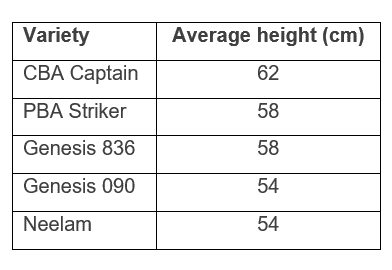
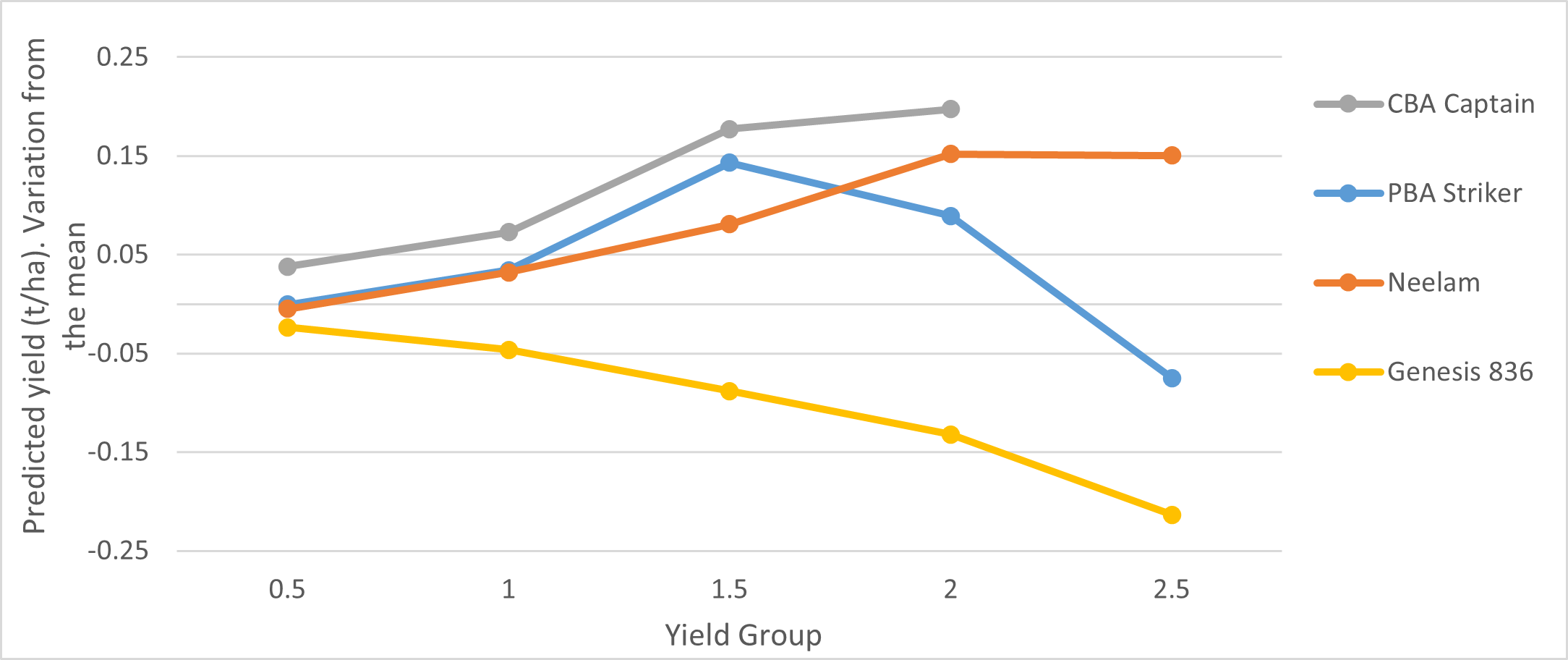
Figure 1: Seed yield of key chickpea varieties in WA. Data includes 2019 NVT MET data (2020 not yet available)
Faba bean chocolate spot management
Research conducted by SARDI in South Australia shows that the causal agent of chocolate spot, Botrytis fabae, needs temperatures between 15-25°C and humidity >75% for spores to be released and infection of new plants to be successful (Davidson & Krysinska-Kaczmarek 2007). Based on this information, SARDI are developing a warning system based on canopy temperature and humidity, as described in the method section of this paper. This will give farmers the information they need to make informed spray decisions, including the confidence to leave a crop unsprayed, therefore reducing the frequency of spray application and minimising the chance of unnecessary foliar fungicide application. Current recommended practice in WA is for farmers to monitor their crop for signs of chocolate spot with a view to begin spraying as the canopy closes and flowering begins through to early pod fill.
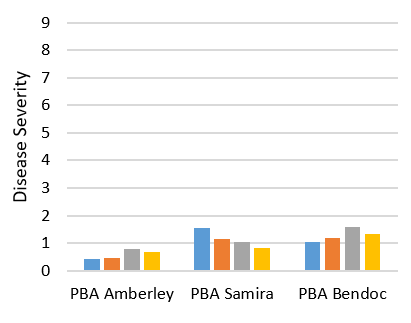
Figure 2: Disease severity as per scale in Table 3, at Frankland River on 20 October.
Fungicide P = not significant, Variety P = 0.004, Fungicide.Variety P = not significant.
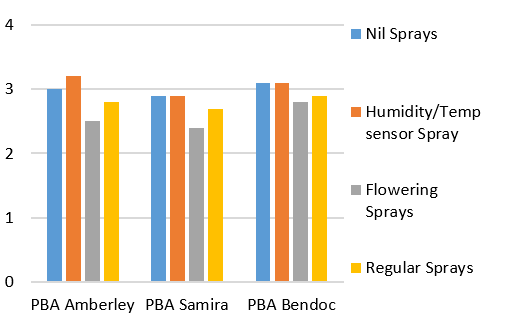
Figure 3: Yield at Frankland River in 2020.
Fungicide P = not significant, Variety P = 0.044, Fungicide.Variety P = not significant.
In 2020 there were very low levels of disease due to weather conditions not favouring disease development. The symptoms of chocolate spot were less severe in PBA Amberley than PBA Bendoc and PBA Samira (Figure 2). Given the MR rating of PBA Amberley compared to MS for PBA Samira and PBA Bendoc, the difference in severity is in line with expectations. PBA Amberley showed a few small specks on leaves, while PBA Bendoc and PBA Samira had specks and some small lesions on leaves and flowers. None of the varieties showed extensive disease. Monitoring showed that humidity in the canopy of the crop was consistently above the 75% threshold, however temperature was not above the threshold 15°C for the required amount of time until the end of September. Therefore, only one spray alert was received on 28 September, when the crop was already podding and yield potential was set. This led to little variation in efficacy and grain yield (Figure 3) of the different fungicide strategies that were trialled and suggests that in 2020 at Frankland River there was only one occasion late in the season when fungicide may have been required to control chocolate spot. In more favourable years for disease development, or at sites where other diseases are present, we would expect fungicide timing to be more important. We see a fit for this kind of monitoring system in WA and DPIRD will continue to assist SARDI as they test and refine the spray alert system before it is commercially released.
Faba bean variety choice
PBA Amberley is the most recently released chickpea variety in Australia. It has performed well in >3t/ha yield environments in WA NVTs (Figure 4). This high yield potential, in combination with its MR chocolate spot resistance, makes it an attractive choice for faba bean growers in high rainfall environments. PBA Samira is a large seeded variety that has been a consistently high performing variety in the Albany port zone over the past few years. PBA Bendoc is the first variety with improved imidazolinone (IMI) tolerance to be released in Australia. It has a fit in IMI-based systems, providing more broadleaf control options. These three varieties make up most of the faba bean area in Western Australia.
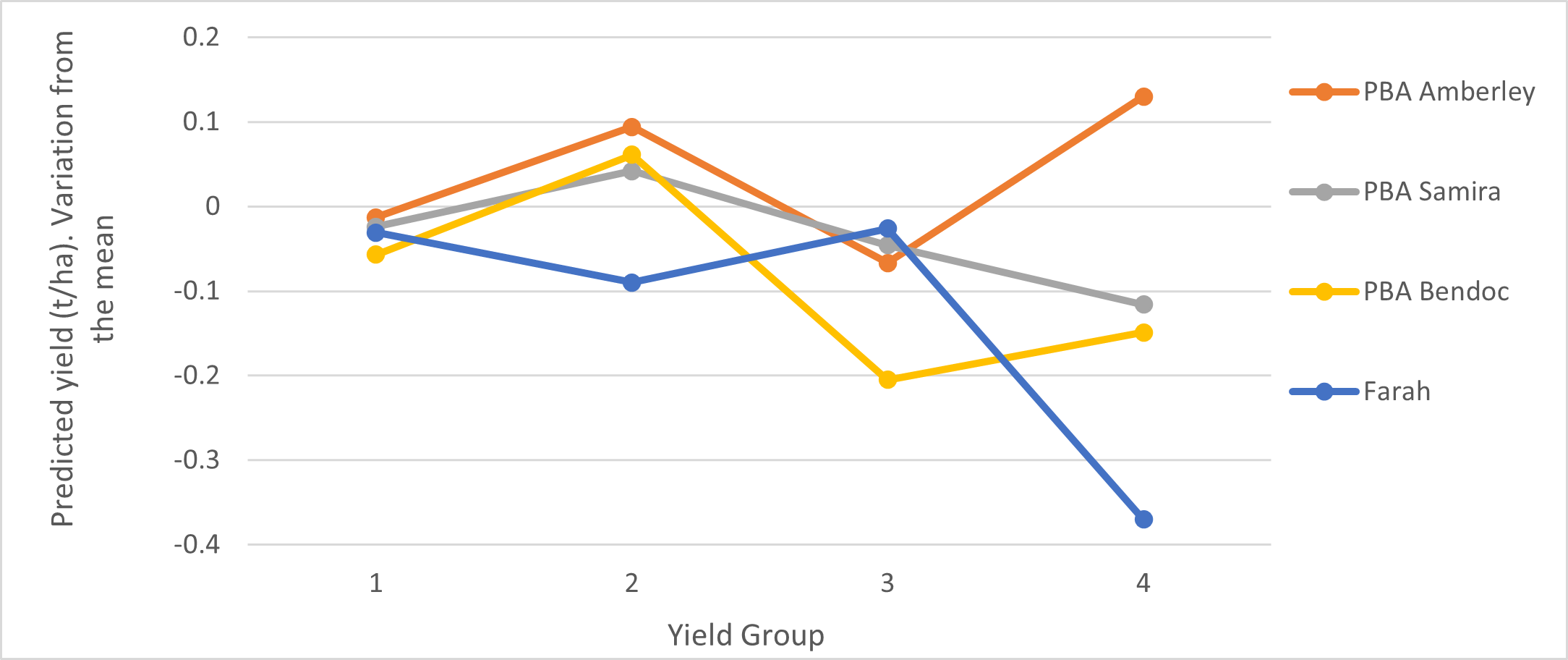
Figure 4: Seed yield of key faba bean varieties in WA. Data includes 2019 NVT MET data (2020 not yet available)
Conclusion
There are now attractive new variety options in both chickpeas and faba beans for growers across WA. Combined with robust disease and weed management packages, these should go a long way to improving grower confidence when introducing a new grain legume or variety in to the rotation.
References
Khani, M., Hancock, A., & Davidson, J. (2020) The health report – do you need to spray for pulse Botrytis diseases? Ask the new data logger. GRDC Research Updates
Davidson, J and Krysinska-Kaczmarek, M (2007). Effects of inoculum concentration, temperature, plant age and interrupted wetness on infection of lentil (Lens culinaris) by Botrytis spp. conidia. Australasian Plant Pathology 36, 389-396.
Acknowledgments
The research undertaken as part of this project is made possible by the significant contributions of growers through both trial cooperation and the support of the GRDC, the author would like to thank them for their continued support. We also thank our grower group co-operators and their members for their continued support.
Contact details
Paper reviewed by Mark Seymour, DPIRD.
Varieties displaying this symbol beside them are protected under the Plant Breeders Rights Act 1994.
GRDC Project Code: DAW1903-004RTX, DAW1907-001RTX,
